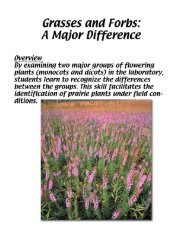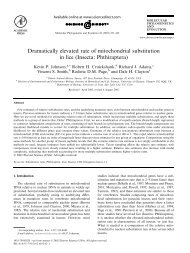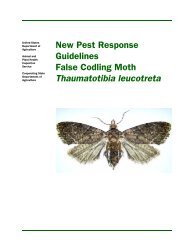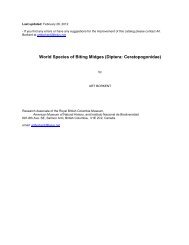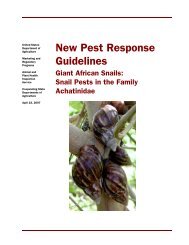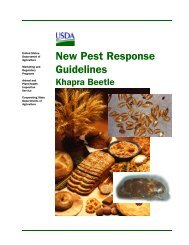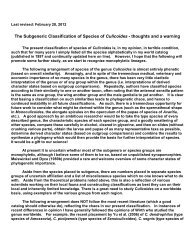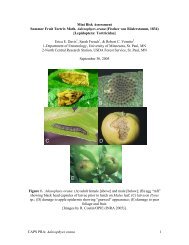Thaumatotibia leucotreta Mini Risk Assessment False codling moth
Thaumatotibia leucotreta Mini Risk Assessment False codling moth
Thaumatotibia leucotreta Mini Risk Assessment False codling moth
- No tags were found...
You also want an ePaper? Increase the reach of your titles
YUMPU automatically turns print PDFs into web optimized ePapers that Google loves.
(Sclerocarya caffra, S.birrea), monkey pod (Cassia petersiana), oak (Quercusspp.), okra (Ablemoschus esculentus), olive (Olea europaea subsp. europaea),peach (Prunus persica), peacock flower (Caesalpinia pulcherrima),pepper/pimento (Capsicum spp.), persimmon (Diospyros spp.), plum (Prunusspp.), pineapple (Ananas comosus), pomegranate (Punica granatum), Pride of DeKaap (Bauhinia galpini), raasblaar (Combretum zeyheri), red milkweed(Mumisops zeyheri), rooibos/bushwillow (Combretum apiculatum), sida (Sidaspp.), snot apple (Azanza garckeana), stamvrugte (Chrysophyllumpalismontatum), sodom apple (Calotropis procera), sorghum (Sorghum spp.),soursop (Annona muricata), stemfruit (Englerophytum magaliesmontanum),Surinam cherry (Eugenia uniflora), suurpruim/large sour plum (Ximenia caffra),tea (Camellia sinensis), water-bessie (Syzygium cordatum), wig-‘n-bietjie(Capparis tomentosa), wild fig (Ficus capensis), wild medlar (Vangueriainfausta), wing bean (Xeroderris stuhlmannii), and yellow-wood berries(Podocarpus falcatus) (Del Valle and March 1972, Reed 1974, Schwartz and Kok1976, Daiber 1980, Bourdouxhe 1982, Anon. 1983, USDA 1984, Javai 1986, LaCroix and Thindwa 1986b, Daiber 1989, Newton 1989a, b, Silvie 1993, Zhang1994, Sétamou et al. 1995, CAB 2003).See Appendix B for a description of where host plants are grown commercially inthe continental US.3. Survey Methodology. Rating: Medium. Visual inspections of plant materialsmay be used to detect eggs, larvae, and adults of T. <strong>leucotreta</strong> (USDA 1984).Eggs will commonly be found on fruits, foliage, and occasionally on branches(USDA 1984). On citrus fruits and other fleshy hosts, dissections are needed todetect larvae; larvae are likely to be found in the pulp (USDA 1984). Infestedfruits may be on or off the tree. In cotton, older larvae may be found in open bollsand cotton seed (USDA 1984). Occasionally adults may be observed on the trunkand leaves of trees in infested orchards (USDA 1984). For field crops such ascorn, the whole plant is the recommended sample unit (Schulthess et al. 1991).Because larvae of T. <strong>leucotreta</strong> have a strongly aggregated spatial distributionamong corn plants, a large sample size (>60 plants) is recommended (Schulthesset al. 1991, Ndemah et al. 2001b); however at low densities of the pest (
Sex pheromones have been identified, and the synthetic conpounds are highlyattractive to males of T. <strong>leucotreta</strong>. Males are attracted to a two component blendof (E)-8-dodecenyl acetate and (Z)-8-dodecenyl acetate (Persoons et al. 1976,1977, Newton et al. 1993). These components are most effective when used in aratio between 70:30 and 30:70 (E:Z) (Persoons et al. 1976, 1977, Angelini 1979,Angelini et al. 1981, Bourdouxhe 1982). More recently, Newton et al. (1993)refined the sex pheromone and reported that a 90:10 ratio was optimal. A loadingrate between 0.5 and 1.0 mg per septum was found to attract the greatest numberof males (Jactel and Vaissayre 1988). The pheromone blend (1 mg applied to arubber septum) has been used effectively with Pherocon 1C traps to capture maleT. <strong>leucotreta</strong> (Newton et al. 1993). Delta traps have also been used (Newton1988b, 1989b, Newton and Mastro 1989, La Croix 1990), but these haveperformed less well than either the Hoechst Biotrap or Pherocon 1C traps(Newton and Mastro 1989, Ochou 1993). Traps using closed polyethylene vialsto dispense pheromones captured more <strong>moth</strong>s than traps using rubber septa (usinga 50:50 blend of (E)- and (Z)-8-dodecenyl acetate La Croix et al. 1985). Luresshould be replaced every 2-4 weeks (Daiber 1978, Jactel and Vaissayre 1988)Traps should be placed approximately 5 ft (1.5m) high (Blomefield 1989, Newtonand Mastro 1989, Newton et al. 1993). Lures should be replaced every 8 wks(PPQ 1993). For routine monitoring, 1-2 traps per acre (2-5 traps/ha) isrecommended (http://www.insectscience.co.za/phertraps.htm). Pheromone traps(homemade design with unspecified pheromone blend) have been used to monitorthe number of T. <strong>leucotreta</strong> adult males in citrus orchards (Daiber 1978) anddetect the presence of the pest in peach orchards (Daiber 1981).Lures for T. <strong>leucotreta</strong> should not be used in the same trap with lures for the pinkbollworm (Pectinophora gossypiella) because the combination of lures results infewer pink bollworm captures (Schwalbe and Mastro 1988). Lures for T.lecutreta can be used in the same trap with lures for P. scutigera (Schwalbe andMastro 1988).Pheromone lures with (E)- and (Z)-8-dodecenyl acetate may also attract Cydiacupressana (native), Hyperstrotia spp. (PPQ 1993), Cydia atlantica (exotic)(Chambon and Frerot 1985), Cydia phaulomorpha (exotic) and Cryptophlebiapeltastica (exotic) (Bourdouxhe 1982, Newton et al. 1993).In citrus, attempts to disrupt mating in T. <strong>leucotreta</strong> with the two-componentpheromone blend successfully disoriented males but failed to reduce damagecaused by larvae (Hofmeyr et al. 1991).4. Taxonomic Recognition. Rating: Low. <strong>Thaumatotibia</strong> <strong>leucotreta</strong> can beconfused with many Cydia spp. including C. pomonella (<strong>codling</strong> <strong>moth</strong>) becauseof similar appearance and damage, however, unlike <strong>codling</strong> <strong>moth</strong> its host rangedoes not include apples, pears or quince (USDA 1984). “In West Africa,T. <strong>leucotreta</strong> is often found in conjunction with Mussidia nigrevenella,” howeverCAPS PRA: <strong>Thaumatotibia</strong> <strong>leucotreta</strong> 4
they can be distinguished by close examination of morphological characters (CAB2000). In South Africa, there is also an overlapping host range for T. <strong>leucotreta</strong>and Cydia peltastica, particularly on litchi and macadamia (Newton and Crause1990).For a more through description of the taxonomy and morphology of T. <strong>leucotreta</strong>,see Appendix C.5. Entry Potential. Rating: Medium. Since 1984, 1,523 interceptions of C.<strong>leucotreta</strong> or “Cryptophlebia sp.” [taxonomy consistent with nomenclature inPIN-309 database] have been reported (USDA 2003). Annually, approximately82 (±7 standard error of the mean) interceptions of C. <strong>leucotreta</strong> or“Cryptophlebia sp.” have been reported (USDA 2003). These interceptions arelargely associated with international airline passengers (97%). The pest has beenintercepted at 34 ports of entry in the United States. Most interceptions werereported from JFK International Airport (33%), Boston (9%), Dallas (9%),Atlanta (7%), Los Angeles (7%), Detroit (5%), Dulles airport (5%), and DesPlaines (5%). These ports are the first points of entry for cargo or airlinepassengers coming into the US and do not necessarily represent the intended finaldestination of infested material. Movement of potentially infested material ismore fully characterized later in this document. Cryptophlebia <strong>leucotreta</strong> or“Cryptophlebia sp.” were intercepted in association with 99 plant taxa (USDA2003).Fumigation with ethylene dibromide (2 hrs @ 16 mg/L) combined with a coldtreatment (21 days at 51°F [11C]) can control T. <strong>leucotreta</strong> in infested citrus(Schwartz and Kok 1976). Cold treatments of 31°F (-0.5C) for 24 days areeffective at eliminating pupae (Myburgh and Bass 1969).6. Destination of Infested Material. Rating: High.. When an actionable pest isintercepted, officers ask for the intended final destination of the conveyance.Material infested with C. <strong>leucotreta</strong> or “Cryptophlebia sp.” (either carried by mailor international airline passengers) was destined for 39 states (including theDistrict of Columbia USDA 2003). The most commonly reported destinationswere New York (29%), Texas (13%), Massachusetts (9%), California (9%),Illinois (7%), Georgia (5%), Michigan (4%), Maryland (3%), Washington, DC(3%), and Minnesota (3%). Of these states, only Texas and California are likelyto have a climate that would support populations of the pest.7. Potential Economic Impact. Rating: High. <strong>Thaumatotibia</strong> <strong>leucotreta</strong> is a pestof economic importance to several crops, including: corn, cotton, citrus, litchi,macadamia, peach and plum, throughout sub-Saharan Africa, South Africa, andthe islands of the Atlantic and Indian Oceans (Schwartz and Kok 1976, Daiber1979, 1980, La Croix and Thindwa 1986a, b, Wysoki 1986, Blomefield 1989,Newton 1989b, Newton and Crause 1990, Silvie 1993, Sétamou et al. 1995).Larval feeding and development can affect fruit development at any stage,CAPS PRA: <strong>Thaumatotibia</strong> <strong>leucotreta</strong> 5
causing premature ripening and fruit drop (Schwartz and Kok 1976, USDA 1984,Newton 1988a, 1989a, Begemann and Schoeman 1999). Damage to corn iscaused from larvae entering the ear from the husk through the silk channel(Ndemah et al. 2001a).All stages of citrus and stone fruits are vulnerable to attack (Newton 1988a).<strong>Thaumatotibia</strong> <strong>leucotreta</strong> larvae are capable of developing in hard green fruitbefore control measures can be started (Catling and Aschenborn 1974). Once afruit is damaged, it becomes vulnerable to fungal organisms and scavengers(Newton 1989a). In peaches, up to 28% loss of late-peach crops has beenreported (CAB 2003). Larvae damage stone fruits as they burrow into the fruit atthe stem end and begin to feed around the stone (Blomefield 1978). Infestationcan be identified by the brown spots and dark brown frass (Blomefield 1978).Peaches become susceptible to damage about 6 weeks before harvest (Daiber1975). Detecting infested peaches can be difficult if fruit is still firm andabscission has not occurred; consequently, the danger of selling potentiallyinfested fruit poses a serious threat to the peach industry (USDA 1984). Onoranges, T. <strong>leucotreta</strong> caused 2-5% damage on Valencia and Navel oranges in1954 (USDA 1984), but yield losses have been as great as 10-20% (CAB 2003).An infested orange shows brown, sunken spots with larval holes bored in thecenter of the spot (Bradley et al. 1979).<strong>Thaumatotibia</strong> <strong>leucotreta</strong> has caused significant yield losses (≥30% ) tomacadamia crops in Israel and South Africa (La Croix and Thindwa 1986a,Wysoki 1986). Damage to macadamia nuts is caused from larvae feeding on thedeveloping kernel after they pierce the husk and shell (La Croix and Thindwa1986a). Nuts reaching 14 – 19 mm diameter size are at the most risk becausenutrient content is the highest; concurrently, T. <strong>leucotreta</strong> reaches the adult stageby this point and is able to oviposit on these nuts (La Croix and Thindwa 1986a).In Ugandan cotton, T. <strong>leucotreta</strong> caused 20% loss of early sown varieties and42 - 90% loss of late varieties (Byaruhanga 1977). Larval penetration of cottonbolls facilitates entry of other microorganisms that can rot and destroy the boll(Couilloud 1994).8. Establishment Potential. Rating: Medium. No wild infestations ofT. <strong>leucotreta</strong> have been reported in the US. The apparently moderate rate ofarrival combined with the potentially limited availability of suitable climatelowers the likelihood of establishment. However because this pest has a broadhost range and suitable host plants are both common and abundant, a relativelyhigh probability of pest establishment exists if the pest were introduced into asuitable climate. Should this pest become established in the US, the economicconsequences are likely to be severe. Thus, the overall degree of risk posed bythis pest is high, and vigilance is warranted.See Appendix D for a more detailed description of the biology of T. <strong>leucotreta</strong>.CAPS PRA: <strong>Thaumatotibia</strong> <strong>leucotreta</strong> 6
References:Angelini, A. 1979. Nouveaux resultats obtenus avec un attractif sexuel de Cryptophlebia<strong>leucotreta</strong> Meyr. (Lepidoptera). Congres sur la Lutte contre les Insectes en MilieuTropical, Marseille, 13-16 mars 2: 145-153. PDFAngelini, A., C. Descoins, J. Lhoste, J. P. Trijau, and P. Zagatii. 1981. Essai denouvelles formulations d'attractifs de synthèse pour le piégeage sexuel deCryptophlebia <strong>leucotreta</strong> Meyr. (Lepidoptera). Coton et Fibres Tropicales 36:259-264. PDFAnon. 1983. <strong>False</strong> <strong>codling</strong> <strong>moth</strong>, an introduction. The Citrus and Subtropical FruitJournal: 4-5. PDFBegemann, G., and A. Schoeman. 1999. The phenology of Helicoverpa armigera(Hübner) (Lepidoptera: Noctuidae), Tortrix capsensana (Walker) andCryptophlebia <strong>leucotreta</strong> (Meyrick) (Lepidoptera: Tortricidae) on citrus atZebediela, South Africa. African Entomology 7: 131-148. PDFBlomefield, T. 1978. Information Bulletin Number 412: Codling <strong>moth</strong>, false <strong>codling</strong><strong>moth</strong> and leafrollers on stone fruits., pp. all. Fruit and Fruit Technology ResearchInstitute, Stellenbosch. PDFBlomefield, T. 1989. Economic importance of false <strong>codling</strong> <strong>moth</strong>, Cryptophlebia<strong>leucotreta</strong>, and <strong>codling</strong> <strong>moth</strong>, Cydia pomonella, on peaches, nectarines andplums. Phytophylactica 21: 435-436. PDFBorror, D. J., C. A. Triplehorn, and N. F. Johnson. 1989. An introduction to the studyof insects. Saunders College Publishing, New York.Bourdouxhe, L. 1982. Résultats de deux années de piégeage sexuel de Cryptophlebia<strong>leucotreta</strong> Meyr. au Sénégal [Results of two years of sexual trapping ofCryptophlebia <strong>leucotreta</strong> Meyr. in Senegal]. FAO Plant protection Bulletin 30:125-129. PDFBradley, J. D., W. G. Tremewan, and A. Smith. 1979. Cryptophlebia <strong>leucotreta</strong>(Meyrick), pp. 208-209, British Trotricoid Moths - Tortricidae: Olethreutinae.The Ray Society, London, England. PDFByaruhanga, E. K. 1977. Manipulation of sowing dates of cotton for the control ofCrypotphlebia leuctreta (Meyrick). pp. 73-75, Proceedings of the 1st E.A.Conference on Entomoology and Pest Control. East African Literature, Nairobi,Kenya. PDFCAB. 2000. Crop protection compendium: global module. Commonwealth AgriculturalBureau International, Wallingford, UK.CAB. 2003. Crop protection compendium: global module. Commonwealth AgriculturalBureau International, Wallingford, UK.Catling, H., and H. Aschenborn. 1974. Population studies of the false <strong>codling</strong> <strong>moth</strong>,Cryptophlebia <strong>leucotreta</strong> Meyr., on citrus in the Transvaal. Phytophylactica 6: 31-38. PDFChambers, B., M. Samways, and I. DA. 1995. Egg distribution of the fruit borersCryptophlebia <strong>leucotreta</strong> (Meyrick) and C. Batrochopa (Meyrick) (Lepidoptera:Tortricidae) and their egg parasitoid Trichogrammatoidea cryptophlebiaeNagaraja (Hymenoptera: Trichogrammatidae) in macadamia trees in Malawi.African Entomology 3: 181-188.CAPS PRA: <strong>Thaumatotibia</strong> <strong>leucotreta</strong> 7
Chambon, J. P., and B. Frerot. 1985. A new tortricid from the Canary Islands Cydiaatlantica N. sp. (Lep. Tortricidae). Anales del Instituto Nacional deInvestigaciones Agrarias 28: 131-136.CIE. 1976. Cryptophlebia <strong>leucotreta</strong> (Meyr.). Distribution Maps of Pests, Series A, MapNo. 352. Commonwealth Institute of Entomology/Commonwealth AgriculturalBureau, Wallingford, UK. PDFCouilloud, R. 1994. Cryptophlebia <strong>leucotreta</strong> (Meyrick) (Lepidoptera: Tortricidae). pp.207-213. In G. A. Matthews and J. P. Tunstall [eds.], Insect Pests of Cotton. CABInternational, Wallingford. PDFDaiber, C. 1978. A survey of male flight of the false <strong>codling</strong> <strong>moth</strong>, Cryptophliebia<strong>leucotreta</strong> Meyr., by the use of the synthetic sex pheromone. Phytophylactica 10:65-72. PDFDaiber, C. 1979. A study of the biology of the false <strong>codling</strong> <strong>moth</strong> [Cryptophlebia<strong>leucotreta</strong> (Meyr.)]: the egg. Phytophylactica 11: 129-132. PDFDaiber, C. 1980. A study of the biology of the false <strong>codling</strong> <strong>moth</strong> Cryptophlebia<strong>leucotreta</strong> (Meyr.): the adult and generations during the year. Phytophylactica 12:187-193. PDFDaiber, C. 1981. <strong>False</strong> <strong>codling</strong> <strong>moth</strong>, Cryptophlebia <strong>leucotreta</strong> (Meyr.) in peachorchards and home gardens of the summer rainfall area of South Africa.Phytophylactica 13: 105-107. PDFDaiber, C. C. 1975. The false <strong>codling</strong> <strong>moth</strong> (Cryptophlebia <strong>leucotreta</strong> Meyr.) inpeaches., pp. 11-17, Proceedings of the First Congress of the EntomologicalSociety of Southern Africa. The Society, Stellenbosch. PDFDaiber, K. C. 1989. The false <strong>codling</strong> <strong>moth</strong>, Cryptophlebia <strong>leucotreta</strong> (Meyr.)(Lepidoptera: Tortricidae), in southern Africa. Zeitschrift für Pflanzenkrankheitenund Pflanzenschutz 96: 71-80. PDFDel Valle, R., and Y. March. 1972. Contribution to the knowledge of some castor-oilplant pests in Mozambique. Agronomie Moçambique 6: 157-175. PDFHofmeyr, J., B. Burger, and F. Calitz. 1991. Disruption of male orientation to femalefalse <strong>codling</strong> <strong>moth</strong>, Cryptophlebia <strong>leucotreta</strong> (Lepicotera: Tortridicae), usingsynthetic sex pheromone. Phytophylactica 23: 153-156. PDFJactel, H., and M. Vaissayre. 1988. Evaluation de la dose optimale et de la rémanencedes phéromones pour le piégeage de Cryptophlebia leuctreta Meyrick(Lepidoptera: Olethreutidae) et Pectinophora gossypiella Saunders (Lepidoptera:Gelechiidae). Coton et Fibres Tropicales 43: 139-146.Javai, I. 1986. Causes of damage to some wild mango fruit trees in Zambia. InternationalPest Control 28: 98-99. PDFKarvonen, J. 1983. Cryptophlebia <strong>leucotreta</strong> imported into Finland (Lepidoptera,Tortricidae). Notulae Entomologicae 63: 94. PDFKlots, A. B. 1970. Lepidoptera, pp. 13-18; 115-130. In S. L. Tuxen [ed.], Taxonomist'sglossary of genitalia in insects. Munksgaard, Copenhagen.Komai, F. 1999. A taxonomic review of the genus Grapholita and allied genera(Lepidoptera: Tortricidae) in the Palaearctic region. Entomologica Scandinavica55 (Suppl.): 1-219.La Croix, E. 1990. Studies on macadamia nut borer (Crytophlebia spp.) in northernMalawi. Tropical Pest Management 36: 97-102. PDFCAPS PRA: <strong>Thaumatotibia</strong> <strong>leucotreta</strong> 8
La Croix, E., and H. Thindwa. 1986a. Macadamia pests in Malawi. III. The majorpests. The biology of bugs and borers. Tropical Pest Management 32: 11-20. PDFLa Croix, E., and H. Thindwa. 1986b. Macadamia pests in Malawi. IV. Control ofbugs and borers. Tropical Pest Management 32: 120-125. PDFLa Croix, E., H. Thindwa, and D. Hall. 1985. Field studies with the synthetic femalesex pheromones of Cryptophlebia batrachopa and C. <strong>leucotreta</strong>, pests ofmacadamia in Malawi. Tropical Pest Management 31: 189-191. PDFMöhr, J. D. 1973. Light trap studies with the false <strong>codling</strong> <strong>moth</strong>. Citrus and Sub-tropicalFruit Journal: 20-22.Myburgh, A., and M. Bass. 1969. Effect of low temperature storage on pupae of false<strong>codling</strong> <strong>moth</strong>, Cryptophlebia (Argyroploce) <strong>leucotreta</strong> Meyr. Phytophylactica 1:115-116. PDFNdemah, R., F. Schulthess, M. Poehling, and B. C. 2001a. Spatial dynamics oflepidopterous pests on Zea mays (L.) and Pennisetum purpureum (Moench) in theforest zone of Cameroon and their implications of sampling schemes. Journal ofApplied Entomology 125: 507-514. PDFNdemah, R., F. Schulthess, S. Korie, C. Borgemeister, and K. Cardwell. 2001b.Distribution, relative importance and effect of lepidopterous borers on maizeyields in the forest zone and mid-altitutde of Cameroon. Journal of EconomicEntomology 94: 1434-1444. PDFNewton, P. 1988a. Inversely density-dependent egg parasitism in patchy distributions ofthe citrus pest Cryptophlebia <strong>leucotreta</strong> (Lepidoptera: Tortricidae) and itsagricultural efficiency. Journal of Applied Ecology 25: 145-162. PDFNewton, P. 1988b. Movement and impact of Trichogrammatoidea cryptophlebiaeNagaraja (Hymenoptera: Trichogrammatidae) in citrus orchards after inundativereleases against the false <strong>codling</strong> <strong>moth</strong>, Cryptophlebia <strong>leucotreta</strong> (Meyrick)(Lepidoptera: Tortricidae). Bulletin of Entomological Research 78: 85-99. PDFNewton, P. 1989a. The influence of citrus fruit condition on egg laying by the false<strong>codling</strong> <strong>moth</strong>, Cryptophlebia <strong>leucotreta</strong>. Entomologia Experimentalis et Applicata52: 113-117. PDFNewton, P. 1989b. Combinations of applications of a chitin synthises inhibitor andinundaitve releases of egg parasitoids against the false <strong>codling</strong> <strong>moth</strong>,Crytophplebia <strong>leucotreta</strong> (Meyrick) (Lepidoptera: Tortricidae), on citrus. Bulletinof Entomological Research 79: 507-519. PDFNewton, P., and C. Crause. 1990. Oviposition on Litchi chinensis by Cryptophlebiaspecies (Lepidoptera: Tortricidae). Phytophylactica 22: 365-367. PDFNewton, P. J., and V. Mastro. 1989. Field evaluations of commercially available trapsand synthetic sex pheromone lures of the false <strong>codling</strong> <strong>moth</strong>, Cryptophlebia<strong>leucotreta</strong> (Meyr.) (Lepidoptera: Tortricidae). Tropical Pest Management 35: 100-104. PDFNewton, P. J., C. D. Thomas, V. C. Mastro, and C. P. Schwalbe. 1993. Improved twocomponentblend of the synthetic female sex pheromone of Cryptophlebia<strong>leucotreta</strong>, and identification of an attractant for C. peltastica. EntomologiaExperimentalis et Applicata 66: 75-82. PDFNye, I. W. B., and D. S. Fletcher. 1991. The generic names of <strong>moth</strong>s of the world. Vol.6: Microlepidoptera. Natural History Museum Publications, London.CAPS PRA: <strong>Thaumatotibia</strong> <strong>leucotreta</strong> 9
Zhang, B. C. 1994. Index of economically important Lepidoptera. CAB International,Wallingford, UK. Insert PDFCAPS PRA: <strong>Thaumatotibia</strong> <strong>leucotreta</strong> 11
Appendix A. Comparison of climate zones. To determine the potentialdistribution of a quarantine pest in the US, we first collected information aboutthe worldwide geographic distribution of the species (CAB 2000). We thenidentified which biomes (i.e., habitat types), as defined by the World WildlifeFund (Olson et al. 2001), occurred within each country or municipality reportedfor the distribution of the species. Biomes were identified using a geographicinformation system (e.g., ArcView 3.2). An Excel spreadsheet summarizing theoccurrence of biomes in each nation or municipality was prepared. The list wassorted based on the total number of biomes that occurred in eachcountry/municipality. The list was then analyzed to determine the minimumnumber of biomes that could account for the reported worldwide distribution ofthe species. Biomes that occurred in countries/municipalities with only onebiome were first selected. We then examined each country/municipality withmultiple biomes to determine if at least one of its biomes had been selected. Ifnot, an additional biome was selected that occurred in the greatest number ofcountries or municipalities that had not yet been accounted for. In the event of atie, the biome that was reported more frequently from the entire species’distribution was selected. The process of selecting additional biomes continueduntil at least one biome was selected for each country. The set of selected biomeswas compared to the occurrence of those biomes in the US.CAPS PRA: <strong>Thaumatotibia</strong> <strong>leucotreta</strong> 12
Appendix B. Commercial production of hosts of<strong>Thaumatotibia</strong> <strong>leucotreta</strong> in the continental US.Map 1. Avocado (Persea americana)Map 2. Banana (Musa paradisiaca)Map 3. Bean; dry, edible (Phaseolus vulgais)Map 4. Bean; green (Phaseolus vulgaris)Map 5. Corn (Zea mays)CAPS PRA: <strong>Thaumatotibia</strong> <strong>leucotreta</strong> 13
Map 6. Cotton (Gossypium hirsutum)Map 7. Cowpea; dry (Vigna unguiculata)Map 8. Cowpea; green (Vigna unguiculata)Map 9. English walnut (Juglans regia)Map 10. Fig (Ficus carica)Map 11. Grape (Vitis spp.)CAPS PRA: <strong>Thaumatotibia</strong> <strong>leucotreta</strong> 14
Map 12. Grapefruit (Citrus paradisi)Map 13. Guava (Psidium guajava)Map 14. Lemon (Citrus limon)Map 15. Lima bean; dry (Phaseolus limensis)Map 16. Lima Bean; green (Phaseolus limensis)Map 17. Lime (Citrus aurantifolia)CAPS PRA: <strong>Thaumatotibia</strong> <strong>leucotreta</strong> 15
Map 18. Macadamia nut (Macadamia ternifolia)Map 19. Mango (Mangifera indica)Map 20. Oak (Quercus spp.)Map 21. Okra (Abelmoschus esculentus)Map 22. Olive (Canarium spp.)Map 23. Orange (Citrus spp.)CAPS PRA: <strong>Thaumatotibia</strong> <strong>leucotreta</strong> 16
Map 24. Peach (Prunus persica)Map 25. Pepper; hot (Capsicum spp.)Map 26. Pepper; sweet (Capsicum spp.)Map 27. Persimmon (Diospyros spp.)Map 28. Pimento (Capsicum spp.)Map 29. Plum & Prune (Prunus domestica)CAPS PRA: <strong>Thaumatotibia</strong> <strong>leucotreta</strong> 17
Map 30. Pomegranate (Punica granatum)Map 31. Sorghum (Sorghum sp.)Map 32. Tangelo (Citrus tangelo)Map 33. Tangerine; honey (Citrus reticulata)Map 34. Tangerine; other (Citrus reticulata)CAPS PRA: <strong>Thaumatotibia</strong> <strong>leucotreta</strong> 18
Appendix C. Taxonomy of <strong>Thaumatotibia</strong> <strong>leucotreta</strong> (Meyrick) and relatedTortricidae (prepared by M. DaCosta).The species name <strong>leucotreta</strong> was removed from the genus Cryptophlebia and placed in<strong>Thaumatotibia</strong> by Komai (1999). The genus <strong>Thaumatotibia</strong> Zacher (1915) was not placedin a family when established, and was instead placed as a synonym of CryptophlebiaWalsingham (1899) (Nye and Fletcher 1991). Species of <strong>Thaumatotibia</strong> andCryptophlebia are similar to each other externally and the two genera are related to eachother. Komai (1999) lists the following characters common to both genera:1) forewing broad (male broader than female), with a blackish triangularpretornal patch and with an accessory cell of chorda small or absent (chordacoincident with the margin of the discal cell)2) hindwing with a short discal cell, especially in males3) eighth tergite (and sometimes preceeding tergites) with a small patch of longscales4) valva with a patch of very long, curled scales on the outer surface of thecucullus5) tenth abdominal segment of pupa with a pair of strong spines along anal rise.<strong>Thaumatotibia</strong> can be distinguished from Cryptophlebia on the basis of the followingcharacters:1) eighth tergite in male with a broadly sclerotized plate with convex posteriormargin and laterally produced into curved points2) sterigma indicated by an ovate or rectangular sclerite connecting posteriorlywith a pair of ovate granulations with modified scales3) corpus bursa with granular patch at juncture of ductus bursae.The species <strong>leucotreta</strong> was placed in one of two species groups in <strong>Thaumatotibia</strong> byKomai (1999), the <strong>leucotreta</strong>-group, which is distinguished from the other species group,the chaomorpha-group, by (1) the presence of tufts of modified scales on the inner side ofthe hindtibia (usually), (2) an enlarged inner apical spur and (3) “normal” juxta.According to Bradley et al. (1979), male T. <strong>leucotreta</strong> are distinguished from otherspecies by the specialized hindwing, which is slightly reduced and has a circular pocketof fine hair-like black scales overlaid with broad weakly shining whitish scales in the analangle, and its heavily tufted hind tibia.Descriptions of the external morphology as well as the genitalia of <strong>Thaumatotibia</strong><strong>leucotreta</strong> (Meyrick) are provided.Synonyms (from Bradley et al. 1979, Nye and Fletcher 1991, Komai 1999)At the generic level:<strong>Thaumatotibia</strong> Zacher,1915: 529-Heppner, 1980: 34 (as synonym of Cryptophlebia).Type species: <strong>Thaumatotibia</strong> roerigii Zacher, 1915 [=Argyroploce <strong>leucotreta</strong> Meyrick,1913] by monotypy• Argyroploce Hübner, [1825]CAPS PRA: <strong>Thaumatotibia</strong> <strong>leucotreta</strong> 19
• Olethreutes Hübner, 1822, Syst. -alphab. Verz.: 58-67, 69, 72. Type species:Phalaena arcuella Clerck, 1759, Icon. Insect. Rariorum 1: pl 10 fig. 8, bysubsequent designation by Walsingham, 1895, Trans. Ent. Soc. Lond. 1895:518.• Metriophlebia Diakonoff, 1969: 89. –Razowski, 1977: 259. –Clarke, 1986:162 (as synonym of Cryptophlebia), syn. n. Type species: Eucosomachaomorpha Meyrick, 1929, by monotypyAt the species level:<strong>leucotreta</strong> (Meyrick) 1913. Ann. Transv. Mus. 3: 267-336.• roerigii Zacher, 1915: 529 Beiträge zur Kenntnis der westafrikanischenPlanzenschädlinge.-Tropenpflanzer 18: 504-534.Diagnosis of <strong>Thaumatotibia</strong> <strong>leucotreta</strong>:[Description from Komai (1999).] Small to medium-sized, grayish-brown to darkbrown/black <strong>moth</strong>s with broad forewings (forewing index: 0.41-0.44mm in males, and0.38-0.42mm in females) with a blackish triangular pretornal patch. Externally species of<strong>Thaumatotibia</strong> are similar to species of Cryptophlebia. Wing venation of <strong>Thaumatotibia</strong>is characterized by a small accessory cell delineated by the chorda from between R2 andR3 (closer to R3) to R4 or from between R1 and R2 (very close to R2) to between R5 andR5, or the absence of accessory cell (the chorda coincident with the margin of the discalcell), and by a short discal cell in the hindwing, especially in the male (0.42-0.43x lengthof the wing). Eigth tergum in male with a broadly sclerotized plate with convex posteriormargin and laterally produced into curved points, with paired patches of long mane-likescales, but without a pair of long filiform scale tufts from shallow membranous pocketson each side of eighth tergum as in Cryptophlebia. Male genitalia are characteristic in thelarge, ovate valva (the outer surface with a patch of very long, curled scales, which isshared with Cryptophlebia), in the sacculus often with teeth distally, and in the juxtasometimes producing caudally a pair of denticulate, ovate lobes (the chaomorpha-group).The female genitalia is characterized by the sterigma indicated by an ovate or rectangularsclerite, connecting posteriorly with a pair of ovate granulations with modified scales, bythe corpus bursae with a ring of granulation at the juncture of the ductus bursae, andsometimes a diverticulum ventrally or laterally.CAPS PRA: <strong>Thaumatotibia</strong> <strong>leucotreta</strong> 20
Description:Head: [Description from Komai (1999).] As in Figure C1. Frons with very dense, erectand moderately long scales. Antenna filiform, less than 2/3 length of forewing. Labialpalps long and wavy; second segment widened distally, but scales appressed and rathershort; terminal segment extends forward horizaontally, about 1/3 length of second,slender, with appressed scales, apex blunt.A B CFigure C1. Lateral views of head. A-Ventrolateral view of general <strong>moth</strong> head [Reproducedfrom Robinson et al. (1994)]. B-Filiform antenna [Reproduced from Borror et al. (1989)] C-Lateral view headof <strong>Thaumatotibia</strong> hemitoma (Diakonoff)-♂. [Reproduced from Komai (Komai 1999)]Thorax: [Description from Komai (1999)] Posterior crest present. Hind tibia (as in Fig.C2) with modified scales on inner side, the inner apical spur enlarged with a batch ofscales, the bases of which have a layer of secreting cells.TARSUSTIBIAABTIBIALSPURSFEMURFigure C2. A-Hindtibia-modified scales and apical spur removed. B-Detail of spurs.[Reproduced from Komai (1999)]Wings: [Description from Bradley et al. (1979).] Forewing pattern a mixture of bluishgray,brown, black, and rust colored red-brown markings, the most conspicuous is theblackish triangular pre-tornal marking and the crescent-shaped marking above it, and aminute white spot in the discal area.CAPS PRA: <strong>Thaumatotibia</strong> <strong>leucotreta</strong> 21
Venation: As in Fig C3. There is a scent organ on the distal 2/3 of CuA2 on upper side.Its presence is indicated by concavity on wing membrane bounded with thickened ridgesbearing the secreting cells [Zagatii and Castel quoted in Komai (1999)].ABFigure C3. Venation of <strong>Thaumatotibia</strong> <strong>leucotreta</strong> (Meyrick), A-male, B-Female. Veins:A-anal; C-Costa, Cu-Cubitus (CuA1-1 st anterior cubitus; CuA2-2 nd anterior cubitus; CuPposteriorcubitus); D-discal cell; M-Media, R-Radius, Sc-Subcosta.[Reproduced from Komai (1999)]Abdomen: [Description from Komai (1999)] As in Fig C4. Second sternite with welldeveloped anterolateral processes and sternal apodemes. Male abdominal scent organs:eighth tergite with a broadly sclerotized plate with convex posterior margin and laterallyproduced into curved points, densely covered with long scales which are easilyremovable.Figure C4. Post abdomen showing: 7 th sternite (S7), 8 th sternite (st. 8), 7 th tergite (T7), 8 thtergite (T8), intersegmental ventral sclerite between abdominal segments 8 and 9 (iss),scale-tufts of coremata (sc) [Reproduced from Komai (1999)]CAPS PRA: <strong>Thaumatotibia</strong> <strong>leucotreta</strong> 22
Male genitalia: [Description from Komai (1999)] As in Fig. C5. Tegumen a broadband, rounded apically; Aedeagus bulbous basally, narrowed at basal 1/4 to 1/3 andupcurved distally; vesica with series of fine cornuti. Juxta producing caudally a pair ofdenticuate, “normal” lobes. [Terminology follows Klots (1970).]TEGUMENVALVEAEDEAGUSFigure C5. Ventral view male genitalia [Reproduced from Komai (1999)]Female genitalia: [Description from Komai (1999)] As in Fig. C6. Papillae anales“moderate”. Anterior apophyses longer than posterior apophyses. Sterigma an ovate, orrectangular raised sclerite, connecting posteriorly with a pair of ovate granulations withmodified scales. Ductus bursa long and narrow, ductus seminalis arising laterally, fromposterior 1/4-1/5 of ductus bursa; bulla seminalis present; corpus bursae ovate, with aring of granulation at juncture of ductus bursa with diverticulum laterally, with two large,curved, blade-shaped signa. Seventh sternite trapezoidal, posterior margin with shallowor deep excavation.PAPILLA ANALESANTERIOR APOPHYSISPOSTERIOR APOPHYSISOSTIUM BURSADUCTUS BURSAOSTIUM BURSADUCTUS BURSACORPUS BURSAFigure C6. Genitalia <strong>Thaumatotibia</strong> <strong>leucotreta</strong> (Meyrick). Left-Entire genital apparatus,Right-ostium bursa and posterior part of bursa copulatrix [Reproduced from Komai (1999)]CAPS PRA: <strong>Thaumatotibia</strong> <strong>leucotreta</strong> 23
Larva: [Description from Komai (1999).] Body length of mature larva 15mm. Headyellowish-brown. Body orange or pink in final instar. Pinacula large, darker than bodycolor. Spiracle on A8 near the posterior margin. Prolegs with 31-40 crochets arranged ina biordinal circle. Anal fork present. Chaetotaxy As in Fig. C7: SD1 and SD2 on samepinaculum on A9; SV group on A1-A6 trisetose, on A7 and A8 bisetose, A9 unisetose; Lgroup trisetose on A9.Figure C7. Setal map of <strong>Thaumatotibia</strong> <strong>leucotreta</strong>; drawing scale a-g: 0.5mm,h-j: 0.1 mm [Reproduced from Komai (1999)]CAPS PRA: <strong>Thaumatotibia</strong> <strong>leucotreta</strong> 24
Pupa: [Description from Komai (1999)] As in Fig. C8. Body length 6-10mm. Body paleyellowish-brown. Similar to Cryptophlebia. Spiracles transversely ovate. A2-A7 with tworows of dorsal spines; A8-A10 with one row of strong spines, in male A8 with two rowsof dorsal spines; A10 with a pair of strong spines along anal rise, without hooked setaeexcept two pairs along anal rise.ANTERIORA POSTERIOR BFigure C8. Pupa of <strong>Thaumatotibia</strong> sp. A-Ventral view, B-Lateral view (scale = 1 mm)[Reproduced from Komai (1999)]CAPS PRA: <strong>Thaumatotibia</strong> <strong>leucotreta</strong> 25
Similar species: Cydia pomonella (Linnaeus)-the <strong>codling</strong> <strong>moth</strong> [occurs in the US]A B CFigure C9. Dorsal views of Cydia pomonella (Linnaeus) A-male, B & C-female (toillustrate degree of morphological variation within a sex).[Reproduced from Bradley et al. (1979)]Figure. C10. Lateral view of head of Cydia pomonella (Linneaus)[Reproduced from Bradley et al. (1979)]Figure C11. Venation of Cydia pomonella[Reproduced from Bradley et al. (1979)]CAPS PRA: <strong>Thaumatotibia</strong> <strong>leucotreta</strong> 26
ABFigure C12. Larva of Cydia pomonella (Linneaus). A-Dorsal view of head,B-lateral view of body; pattern of crochets [Reproduced from Bradley et al. (1979)]CAPS PRA: <strong>Thaumatotibia</strong> <strong>leucotreta</strong> 27
Appendix D. Biology of <strong>Thaumatotibia</strong> <strong>leucotreta</strong>Population phenology<strong>Thaumatotibia</strong> <strong>leucotreta</strong> has 2-10 generations annually (Daiber 1980, Couilloud 1994,Begemann and Schoeman 1999). The number of generations is determined by severalfactors including temperature, food availability/quality, photoperiod, humidity, latitudeand the effect of predators and diseases (Catling and Aschenborn 1974, Daiber 1979,1980, Newton 1988a, b, Newton and Crause 1990, Couilloud 1994, Begemann andSchoeman 1999). With an uninterrupted supply of plant hosts T. <strong>leucotreta</strong> remainsactive throughout the year (Blomefield 1978, Newton 1988b). Four generations canoccur per season on navel oranges (Daiber 1975). Five generations can be completed inSouth Africa (Daiber 1980), although a laboratory study suggested 10 generationsannually are possible in this region (Begemann and Schoeman 1999).Stage specific biologyAdults. The life span of adults depends largely on temperature, regional climaticconditions and host availability (Daiber 1980, Couilloud 1994). Moths may live 1-6weeks, or up to ~28 weeks under favorable winter conditions in South Africa (Daiber1980, Couilloud 1994). At warmer temperatures (e.g., 10-15°C), reproduction isgenerally greater, but life span is shorter, than at cooler temperatures (e.g., 20-25°C)(Daiber 1980). On average, females live longer than males (Daiber 1980). The ratio ofmales to females is 1:2 (Couilloud 1994).Emergence occurs early in the morning (Couilloud 1994). Moths are active at night andspend daytime hours resting on shaded portions of the host (Blomefield 1978, Couilloud1994). Moth activity increases with the onset of host flowering (Newton 1989a).Moths can mate several times per day (Couilloud 1994). Oviposition occurs on or neardeveloping fruit after petal fall (Daiber 1975, Newton 1989b, Ochou 1993).<strong>Thaumatotibia</strong> <strong>leucotreta</strong> females prefer specific parts of the host plant for oviposition.Females tend to choose smooth, non-pubescent surfaces for egg-laying. On cotton,green bolls are preferred (Couilloud 1994). On peach, eggs are deposited near fruit onsmooth leaves (Blomefield 1978)(Newton, 1988a). Moths also tend to select areas onfruit with damage (Blomefield 1978, Newton and Crause 1990).The onset and degree of oviposition vary with temperature and host plant (Daiber 1980,Chambers et al. 1995). Egg-laying begins 2-3 days after emergence (Blomefield 1978).Eggs are laid singly or in small groupings of 2-4 “overlapping like tiles” on or near fruitsurfaces (Daiber 1980, Blomefield 1989, Newton and Crause 1990, Couilloud 1994).Eggs are only laid between 5pm and 10pm (Daiber 1980). A female will generallyproduce between 87-456 eggs depending on temperature [within a range of 15-25°C](Daiber 1980). However, individual female fecundity can vary from 5-799 eggs(Daiber 1980).CAPS PRA: <strong>Thaumatotibia</strong> <strong>leucotreta</strong> 28
EggEggs. Egg development takes 2-22 days depending on temperature (Daiber 1979).Eggs are extremely sensitive to cold temperatures and extended periods of lowhumidity. Temperatures below 0°C over a 2-3 day period can kill eggs (Blomefield1978, Daiber 1979).Larvae wander for a short while before tunneling into the host fruit, where most of thelarval stage is spent (Blomefield 1978, La Croix and Thindwa 1986b, Newton andCrause 1990, Couilloud 1994). The duration of this stage may vary widely (from 4-173days), depending on temperature and host plant (Blomefield 1978; Daiber1979b)(Daiber 1979, Daiber 1989, Couilloud 1994). <strong>Thaumatotibia</strong> <strong>leucotreta</strong> has upto 5 instars (Bradley et al. 1979, Couilloud 1994). The last instar is typically completedin fruit. A larva prepare to pupate by leaving the fruit and spinning a cocoon with silkand soil particles (USDA 1984). Pupation occurs on the soil surface, in the soil, increvices under bark, in dropped fruit or in debris (Blomefield 1978, USDA 1984, LaCroix and Thindwa 1986a, Daiber 1989, Newton and Crause 1990).Pupae emerge slightly from the cocoon before adult emergence takes place. “Theempty pupal skin usually remains attached to the cocoon” (Daiber 1989).Under laboratory conditions, the pupal stage lasts between 2-33 days, depending ontemperature (Daiber 1989). Pupae are also sensitive to cold temperatures and heavyrainfall (Daiber 1989). Pupae that have completed ¼ to ½ of their development tend tobe more cold resistant than older or younger pupae (Myburgh and Bass 1969).Several studies have described the developmental threshold and accumulated degreedays necessary for the completion of each life stage (Table D1).StageTable D1. Developmental threshold and degree day requirementsfor <strong>Thaumatotibia</strong> <strong>leucotreta</strong>Developmental Degree Days NotesReferencethreshold (˚C) (± SE)11.93 51.2-69.3 Lab study (Daiber 1979)11.7 69.4±3.2 Calculated from (Daiber 1975)author’s dataLarva 11.6-12.5 156 Lab study (Daiber 1979)Pupa 11.9 174 (females) Lab study (Daiber 1979)186 (males)Adult 8 232±4.2 Male life span; (Daiber 1980)calculated fromauthor’s Table 18.1 229.8±3.8 Male life span;calculated fromauthor’s Table 5(Daiber 1975)9.5 243.5±12.3 Female life span;calculated fromauthor’s Table 1(Daiber 1980)CAPS PRA: <strong>Thaumatotibia</strong> <strong>leucotreta</strong> 29
StageDevelopmentalthreshold (˚C)Degree Days(± SE)Notes9.7 237.8±10.9 Female life span;calculated fromauthor’s Table 56.4 242.8±18.1 Oviposition period;calculated fromauthor’s Table 512.2 79.2±3.8 Time to 50% eggslaid; calculatedfrom author’sTable 115 12.8±2.8 Preovipositionperiod; calculatedfrom author’s Table5Reference(Daiber 1975)(Daiber 1975)(Daiber 1980)(Daiber 1975)CAPS PRA: <strong>Thaumatotibia</strong> <strong>leucotreta</strong> 30



